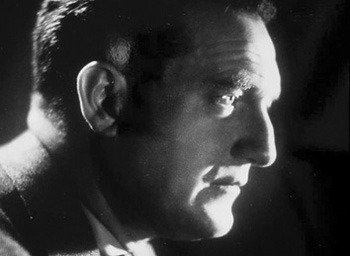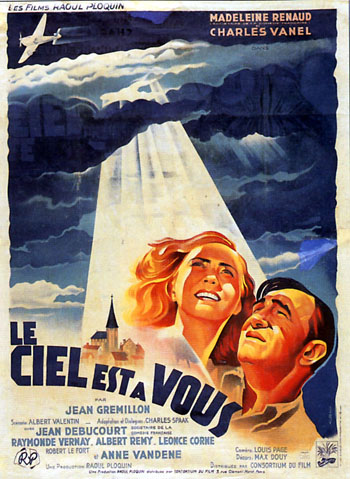Criterion’s release last week of Jean Grémillon During the Occupation on its no-frills label Eclipse follows a presentation of a series of the overlooked director’s work at Il Cinema Ritrovato in Bologna last month where, on the very first day of the festival, Tom Paulus led a robust chorus declaring Grémillon “major (re)discovery.” Eclipse Series 34 collects Remorques (1941), Lumière d’été (1943), and Le ciel est à vous (1944), “all uncommonly attuned to the beauty and hardships of human experience,” writes Criterion’s own Michael Koresky. “They are at once carefully designed and sublimely naturalistic works, with an unerring way of bringing into focus moments of grace amid sometimes overwrought plots, and with a bottomless empathy for their characters. Grémillon never achieved the prominence he might have—perhaps in part because his distaste for the dictates of studio bosses sometimes outweighed his instinct for self-preservation, resulting in fewer of his films being made—and his name has often been left out of the conversation about French filmmaking. But his is an essential voice from a key period in film history, one with a dark romanticism and graceful subtlety of expression. And he has never been completely without champions. As Elliott Stein wrote in 2002, echoing the sentiments of at least a few other critics, ‘Grémillon belongs in the hierarchy of classic French cinema along with René Clair, Jean Renoir, and Marcel Carné.'”
“Trained as a musician and composer, he first came into contact with films professionally when he played in a small orchestra that accompanied silent pictures,” wrote Jonathan Rosenbaum in 2002, “and many critics have noted that he tended to structure his films in movements, as if they were pieces of music…. He started out making documentaries and experimental films; aspects of them can be found in his subsequent features, which were always populist by design. I suspect that his career was so checkered—he was forced to work in Spain in the 30s and on documentary shorts throughout most of the 50s—in part because of the cross-purposes and temperamental conflicts of an intellectual leftist member of the French resistance who wanted to reach a wide public. (His bisexuality may have intensified those conflicts.) He was sufficiently well-known within his profession to have served as president of the Cinémathèque Francaise from 1943 to 1958, but when he died the following year—on the same day as matinee idol Gérard Philipe—he’d largely been forgotten.”
“[B]etween the time it was conceived and the time it saw the light of day, Remorques had become, in effect, a fantasy,” writes Dave Kehr in the New York Times:
It tells, in Grémillon’s rich, moody, highly metaphorical style, the story of André Laurent (Jean Gabin), the captain of a salvage ship operating out of the port of Brest, on the westernmost point of the Breton peninsula, who falls reluctantly and adulterously in love with Catherine (Michèle Morgan), a woman he has rescued from a drifting freighter.
The story, shrouded in the voluptuous gloom of the French poetic realism school of the late 1930s, was plausible enough in 1939, but by 1941 the entire Atlantic seacoast was a military zone, and no civilian vessels were operating without German supervision. But there are no Germans in Remorques, or in any of the other films in this collection. In the French popular cinema of the period it was as if the Occupation had never occurred—a studied omission that somehow suited both the conquerors and the conquered.
But if the Occupation is invisible, it is palpably present in the stifling atmosphere—of dread, paralysis and confinement—that pervades classics of the era like La Main du Diable (1943), from Maurice Tourneur, and Le Corbeau (1943), from Henri-Georges Clouzot. Grémillon’s Occupation films seem somehow to escape the claustrophobia that defines the work of many of his colleagues, at times by going to an opposite extreme.
“Which picture is true about the occupied France,” asks Ehsan Khoshbakht in MUBI’s Notebook, “the one we see in Le corbeau or is it the one depicted by Grémillon in Lumière d’été?” Ehsan’s answer is not a simple one, and he begins by noting that the film “was supported by both sides,” that “money from Vichy and Fascist Italy led to the birth of one of the most anti-tyranny, anti-fascist films of the occupation years.” He ultimately argues that “Grémillon deserves to be regarded as one of the most courageous and innovative filmmakers in the history of French cinema,” and what’s more, “Lumière d’été shouldn’t be limited to a commentary on the occupation. Instead, a broader view of France that carries some of the anti-bourgeois features of La règle du jeu, should be taken into account.”
“You cannot consider Lumière d’Eté without comparing it to Renoir’s masterpiece,” agrees Tom Paulus: “both films are essentially chamber pieces that use (theatrical) genres—farce and comedy of manners in the case of Renoir, melodrama in the case of Grémillon—to structure their allegorical content; and both films end in a Walpurgis night, an out-of-control carnival during which all masks fall off; a shotgun is fired in both stories and both films end with an (accidental) death. And yet there are huge differences between the films that elucidate Renoir and Grémillon’s core aesthetic strategies.” He elaborates at Photogénie.
“In sharp contrast to the egalitarian embarrassment of both Renoir and Carné,” writes Joseph Jon Lanthier in Slant, “Grémillon’s sympathies were unflinchingly—perhaps even feverishly—with the rugged working class. Adverse to decadence among the upper class and bohemians alike, Grémillon’s 1940s films are love letters to industrial modernism—to sinewy, self-made men (and women), and the elegantly primitive geometry of their tools.”
For Sean Axmaker, Lumière d’été is ultimately “a portrait of upper-class corruption poisoning the country and then heroic efforts of the working folk to save it.”
Girish Shambu‘s posted notes on two films by Grémillon that he saw in Bologna. Le ciel est à vous is an “‘aviatrix film’ with a rich set of characters and an utterly convincing ‘realism’ of human interactions. It’s a work brimming with grace notes and casually suspended sub-plots.” The other is Maldone (1927), “a thrillingly inventive film, deeply marked by its French impressionist moment, that puts an arsenal of effects to work: startling compositions and changes in shot scale, free cutting, expressive camera movement (including hand-held), unexpected super-impositions, and so on. Grémillon achieves a musical dynamism by modulating between passages of contrasting rhythm.”
Kristin Thompson caught Maldone, Gardiens des phare (1929), L’étrange Monsieur Victor (1938), Remorques, “and Pattes blanches (literally, ‘White putties,’ 1948). I enjoyed them all, and yet there was no sense of discovering an overlooked genius. Best of the sound features for me was Pattes blanches, which tempered Grémillon’s taste for melodrama with a hint of surrealism. The obsessive young wastrel Maurice (played by a very young Michel Bouquet), the gamine hunchback maid who falls in love with the reclusive and menacing local nobleman, and the nobleman himself, invariably bizarrely clad in his white puttees, help give the film a fascination that the others, for me at least, lack.”
Back to Ehsan Khoshbakht, where, at his own blog, he considers “two sequences of Gueule d’amour [1937], known in English as The Lady Killer. This story of a tragic love (a central theme for many poetic realist films of the 1930s) articulates Grémillon’s visual thinking, his style and his very peculiar way of representing the reality on screen.”
For news and tips throughout the day every day, follow @KeyframeDaily on Twitter and/or the RSS feed. Get Keyframe Daily in your inbox by signing in at fandor.com/daily.






